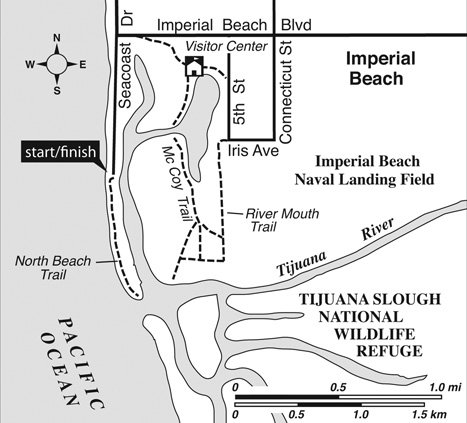 Facebook
Facebook
 X
X
 Instagram
Instagram
 TikTok
TikTok
 Youtube
Youtube

Imperial Beach’s beaches are not as glamorous as others farther north, but they do include some very secluded stretches of sand, including the one described here, lying within the Tijuana Slough National Wildlife Refuge.
To get there, drive to the south end of Imperial Beach’s Seacoast Drive, where hopefully you can find a parking space nearby. At the street’s dead end, a planked walkway and interpretive plaques off to the left introduce you to the green tidal marshlands of the Tijuana River Estuary to the east. All of that is part of a four-square-mile tideland expanse managed by various national, state, and local agencies. This is one of Southern California’s most important coastal wetland areas simply because it has been mostly spared from commercial and housing developments. The area is a recognized haven for birds. More than 400 species have been logged here so far, which is no surprise since the estuary is a key stopover on the Pacific Flyway — the equivalent of Interstate 5 for bird-migration traffic. The marsh’s endangered inhabitants include the light-footed clapper rail and the California least tern. Visiting birds include ospreys, golden eagles, and peregrine falcons.
The beach walk itself begins with a little hop over rocks to the sandy beach. Modern houses and condominiums line the sandy strip to the north, and absolutely nothing in the way of buildings lies south, the direction you travel. Artificial dunes back up the beach to the left — they’re closed to protect nesting terns. Depending on the level of the tide, you could be edging close alongside those dunes or enjoying a wide, glassy smooth expanse of wet sand, dimpled with rounded pebbles here and there. Low tide is definitely better.
At 0.8 mile from then start, you reach the mouth of the Tijuana River, which drains a substantial area of both Baja California (two-thirds of the river’s drainage area, including the city of Tijuana) and San Diego County (one-third of the river’s drainage area). When storm runoff courses down the river, it’s fascinating to watch the outrushing turbid freshwater mixing with the incoming blue-green ocean waves. In winter, gulls set up shop here, feeding in the water and wheeling overhead in great flocks.
The water quality of the Tijuana River is of variable and often dubious quality, so it’s not a great idea to wade or swim in the river mouth area. Most swimmers and surfers tend to hang out near the Imperial Beach Pier, a mile north of the starting point, where the beach is lifeguarded during the warmer months, and the ocean water quality is better. The nearest drinking water and public restrooms are also located near that pier.
Imperial Beach Walk
Looking for secluded beach? Try the one just south of Imperial Beach.
Distance from downtown San Diego: 14 miles
Hiking length: 1.6 miles round trip • Difficulty: Easy


Imperial Beach’s beaches are not as glamorous as others farther north, but they do include some very secluded stretches of sand, including the one described here, lying within the Tijuana Slough National Wildlife Refuge.
To get there, drive to the south end of Imperial Beach’s Seacoast Drive, where hopefully you can find a parking space nearby. At the street’s dead end, a planked walkway and interpretive plaques off to the left introduce you to the green tidal marshlands of the Tijuana River Estuary to the east. All of that is part of a four-square-mile tideland expanse managed by various national, state, and local agencies. This is one of Southern California’s most important coastal wetland areas simply because it has been mostly spared from commercial and housing developments. The area is a recognized haven for birds. More than 400 species have been logged here so far, which is no surprise since the estuary is a key stopover on the Pacific Flyway — the equivalent of Interstate 5 for bird-migration traffic. The marsh’s endangered inhabitants include the light-footed clapper rail and the California least tern. Visiting birds include ospreys, golden eagles, and peregrine falcons.
The beach walk itself begins with a little hop over rocks to the sandy beach. Modern houses and condominiums line the sandy strip to the north, and absolutely nothing in the way of buildings lies south, the direction you travel. Artificial dunes back up the beach to the left — they’re closed to protect nesting terns. Depending on the level of the tide, you could be edging close alongside those dunes or enjoying a wide, glassy smooth expanse of wet sand, dimpled with rounded pebbles here and there. Low tide is definitely better.
At 0.8 mile from then start, you reach the mouth of the Tijuana River, which drains a substantial area of both Baja California (two-thirds of the river’s drainage area, including the city of Tijuana) and San Diego County (one-third of the river’s drainage area). When storm runoff courses down the river, it’s fascinating to watch the outrushing turbid freshwater mixing with the incoming blue-green ocean waves. In winter, gulls set up shop here, feeding in the water and wheeling overhead in great flocks.
The water quality of the Tijuana River is of variable and often dubious quality, so it’s not a great idea to wade or swim in the river mouth area. Most swimmers and surfers tend to hang out near the Imperial Beach Pier, a mile north of the starting point, where the beach is lifeguarded during the warmer months, and the ocean water quality is better. The nearest drinking water and public restrooms are also located near that pier.
Imperial Beach Walk
Looking for secluded beach? Try the one just south of Imperial Beach.
Distance from downtown San Diego: 14 miles
Hiking length: 1.6 miles round trip • Difficulty: Easy